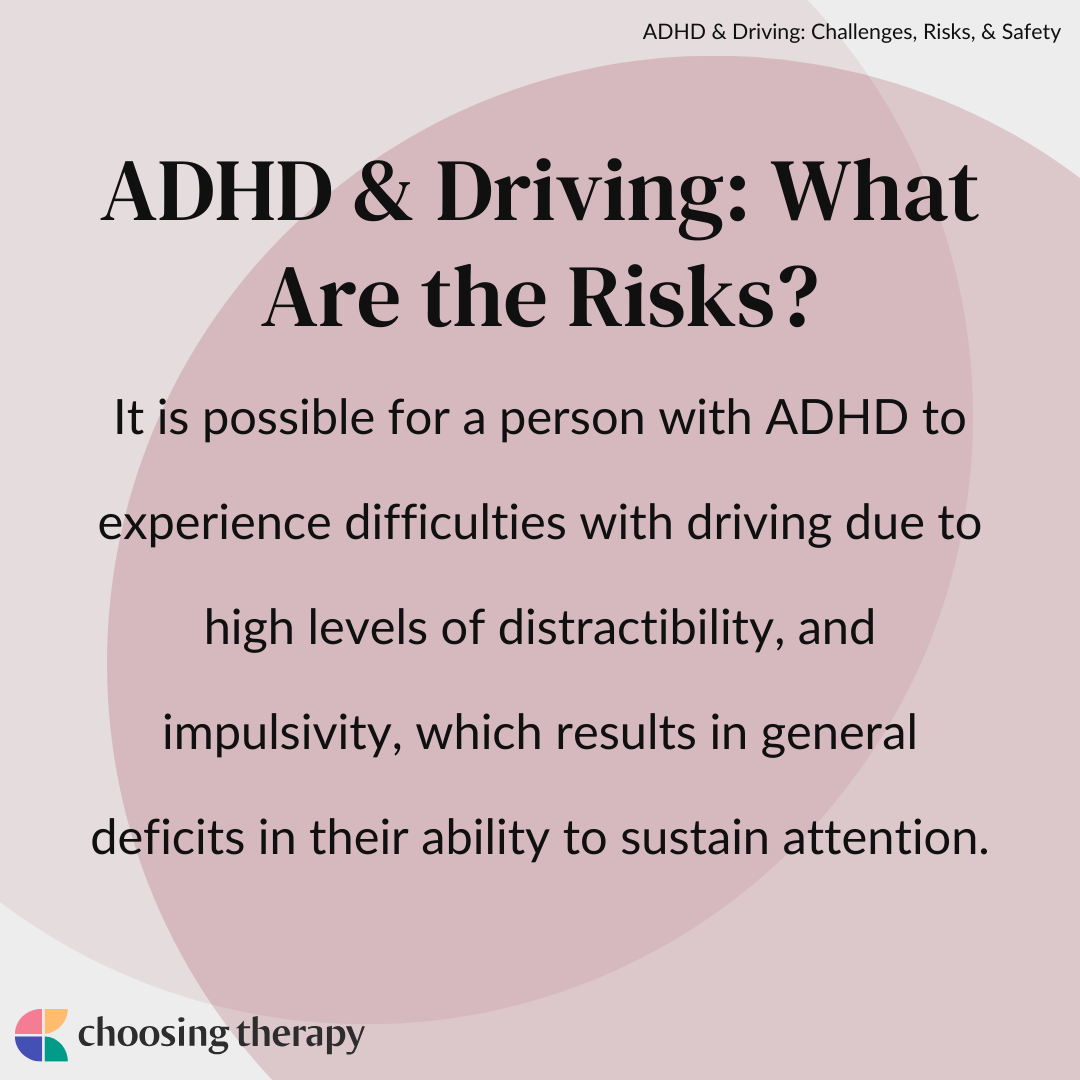ADHD And Driving: Research-Based Safety Strategies

Table of Contents
Car accidents are a leading cause of death and injury, and for individuals with ADHD, the risks can be significantly higher. The challenges posed by ADHD, such as inattention, impulsivity, and hyperactivity, can directly impact driving ability, leading to increased accident risk. This article focuses on ADHD and driving, providing research-based strategies to improve driving safety for individuals with this condition. We'll explore the unique challenges faced by drivers with ADHD and offer practical solutions to enhance their safety on the road.
H2: Understanding the Challenges of Driving with ADHD
Driving requires sustained attention, careful planning, and quick reaction times – skills that can be significantly impaired by ADHD. Let's examine the specific challenges:
H3: Inattention and Distractibility:
Inattention is a core symptom of ADHD. While driving, this manifests as difficulty focusing on the road, leading to increased risk-taking and slower reaction times.
- Examples of distractions: Cell phones, loud music, internal thoughts (racing thoughts, daydreaming), navigating unfamiliar routes.
- Impact on driving: Difficulty maintaining lane position, missing traffic signals or signs, delayed braking responses.
- Research consistently shows that individuals with ADHD have slower reaction times compared to their neurotypical peers, significantly increasing the risk of accidents.
H3: Impulsivity and Risk-Taking:
Impulsivity contributes to unsafe driving behaviors such as sudden lane changes, speeding, and tailgating. These impulsive actions often occur without proper consideration of potential consequences.
- Examples of impulsive driving behaviors: Erratic lane changes, exceeding speed limits, failing to yield right-of-way, following too closely.
- Studies suggest a correlation between impulsivity in individuals with ADHD and a higher rate of traffic accidents.
H3: Hyperactivity and Restlessness:
Hyperactivity can manifest as restlessness and fidgeting, making it difficult to maintain sustained attention while driving, particularly on long journeys. This can lead to driver fatigue and reduced focus.
- Examples of hyperactivity while driving: Constant fidgeting, shifting in the seat, difficulty staying alert on long drives.
- Strategies for managing hyperactivity before driving include exercise, meditation, or listening to calming music. Ensuring adequate sleep is crucial.
H2: Research-Based Safety Strategies for Drivers with ADHD
Fortunately, various strategies can mitigate the risks associated with ADHD and driving. These include medication management, behavioral modifications, adaptive driving techniques, and utilizing supportive resources.
H3: Medication Management:
Medication, prescribed by a healthcare professional, can significantly improve focus and attention. However, it's crucial to discuss potential side effects and their impact on driving with your doctor.
- Types of medication: Stimulants and non-stimulants are commonly prescribed for ADHD, each with its own potential impact on driving ability.
- Important considerations: Some medications can cause drowsiness or other side effects that may impair driving. Careful monitoring and open communication with your doctor are crucial.
H3: Behavioral Strategies:
Implementing behavioral strategies can significantly enhance driving safety.
- Mindful driving: Focusing on the present moment and actively engaging with the driving task.
- Visual reminders: Using checklists to ensure pre-driving checks (seatbelt, mirrors, etc.) are completed.
- Avoiding peak fatigue times: Scheduling driving for times of day when you're most alert.
- Driving in less congested areas: Choosing routes with lighter traffic to minimize stress and distractions.
H3: Adaptive Driving Techniques:
Modifying driving habits can further improve safety.
- Driving shorter distances: Breaking long trips into smaller segments.
- Avoiding stressful driving situations: Minimizing driving during rush hour or in heavy traffic.
- Utilizing GPS navigation: Reducing the cognitive load of navigation and allowing for more focused attention on the road.
- Driving aids and assistive technologies: Exploring adaptive cruise control, lane departure warning systems, and other assistive technologies.
H3: Support Systems and Professional Help:
Seeking professional help and utilizing support systems is crucial.
- Therapy: Cognitive Behavioral Therapy (CBT) can help develop coping mechanisms for managing ADHD symptoms.
- Support groups: Connecting with others who understand the challenges of ADHD and driving can provide valuable support and shared experiences.
- Driving rehabilitation programs: Specialized programs designed to help individuals with ADHD improve their driving skills and safety.
- Open communication: Discussing driving concerns with family and friends can provide valuable support and ensure safer driving practices.
H2: The Role of Driving Instructors and Therapists
Specialized professionals can play a significant role in enhancing driving safety for individuals with ADHD.
H3: Specialized Driving Instruction:
A driving instructor specializing in ADHD can tailor instruction to address specific challenges.
- Focus areas: Risk management, defensive driving techniques, and strategies for managing inattention, impulsivity, and hyperactivity.
H3: Therapeutic Interventions:
Therapy can address underlying issues contributing to driving difficulties.
- CBT: Helps develop strategies for managing impulsivity, improving focus, and enhancing self-regulation.
- Coaching: Provides personalized support and guidance for improving driving skills and addressing specific challenges.
Conclusion:
Managing ADHD and driving requires a multi-faceted approach. Understanding the challenges posed by ADHD, coupled with proactive strategies like medication management, behavioral modifications, adaptive driving techniques, and professional support, is key to improving driving safety. Take control of your driving with ADHD by implementing these research-based strategies for safer driving. Consult a healthcare professional to discuss your driving concerns and ADHD. Learn more about resources available for drivers with ADHD and take the steps necessary to improve your driving safety today.

Featured Posts
-
 China Approves Hengrui Pharmas Hong Kong Share Offering
Apr 29, 2025
China Approves Hengrui Pharmas Hong Kong Share Offering
Apr 29, 2025 -
 Anticipating Shen Yuns Mesa Performance
Apr 29, 2025
Anticipating Shen Yuns Mesa Performance
Apr 29, 2025 -
 Is Betting On Natural Disasters Like The Los Angeles Wildfires The New Normal
Apr 29, 2025
Is Betting On Natural Disasters Like The Los Angeles Wildfires The New Normal
Apr 29, 2025 -
 Mwaeyd Wamakn Fealyat Fn Abwzby Bdayt Mn 19 Nwfmbr
Apr 29, 2025
Mwaeyd Wamakn Fealyat Fn Abwzby Bdayt Mn 19 Nwfmbr
Apr 29, 2025 -
 Descifrando El Exito Goleador El Caso De Alberto Ardila Olivares
Apr 29, 2025
Descifrando El Exito Goleador El Caso De Alberto Ardila Olivares
Apr 29, 2025
Latest Posts
-
 Ray Epps Defamation Lawsuit Against Fox News Details Of The January 6th Allegations
May 12, 2025
Ray Epps Defamation Lawsuit Against Fox News Details Of The January 6th Allegations
May 12, 2025 -
 Cocaine At The White House Secret Service Wraps Up Investigation
May 12, 2025
Cocaine At The White House Secret Service Wraps Up Investigation
May 12, 2025 -
 White House Cocaine Found Secret Service Concludes Inquiry
May 12, 2025
White House Cocaine Found Secret Service Concludes Inquiry
May 12, 2025 -
 The Most Emotional Rocky Movie According To Sylvester Stallone
May 12, 2025
The Most Emotional Rocky Movie According To Sylvester Stallone
May 12, 2025 -
 Which Rocky Movie Touches Sylvester Stallone The Most
May 12, 2025
Which Rocky Movie Touches Sylvester Stallone The Most
May 12, 2025
